There was no liver, no Chianti, and no psychopaths. It was just the pasta from the last two Casa SaltShaker meals, and a couple of requests for more details on it. Now, my version of this dish is not 100% traditional, it’s more just solidly based on a classic from Sicily and/or southern Italy, called Casarecce con le fave. “Fave” are fava or broad beans (mildly different varieties of the same species of bean, and interchangeable). It’s one of my favorite spring pasta dishes, and based on responses from the folk who tried it, and from Henry, it’s going to be up there among theirs too.
Okay – this isn’t all for the pasta, it’s all the prep, or most of it, for a three-course lunch. The pasta stuff is kind of in the center – with a dish of parboiled and peeled broad beans, another of thinly sliced leeks and chilies, a mix of grated pecorino romano and ricotta salata (salted and pressed ricotta), prosciutto cut in thin strips the same way we cut the guanciale for some of our earlier pastas. Not pictured, the pasta itself – casarecce – which is like 1½” long s-scrolls of pasta. Although I’ve made them by hand before, it’s tedious, and in this case I used dried ones from one of the better Italian brands, Garofalo. Also not pictured, a little olive oil, salt, pepper, and a handful of fresh mint leaves.
Because the prosciutto just doesn’t have the amount of fat to render that guanciale does, I use a splash of olive oil to start the process. Low heat again, rendering out as much of the fat as we can, and browning the prosciutto.
Add in the slivered leeks and chilies and cook for about 5 minutes to soften them. Staying over low heat.
Add in the par-cooked beans. Notes on that here. They’re already cooked, so you’re really just warming them up and can move immediately on to the next step. Add a ladleful of the starchy pasta water and start that emulsifying….
Turn up the heat, and as with our previous pastas, scoop the casarecce out of the water about two minutes short of being done. That way, along with some more of the pasta water, they’ll finish cooking both absorbing the flavors in the pot and also adding to that emulsifying, clinging sort of process. I also add some cracked pepper at this point – not a lot, the pasta already has a bit of spice from the chilies.
When the pasta is ready, remove it from the heat. Add the cheese “cream” which we’ve made by melting the cheese with a couple of tablespoons of the hot starchy water and stirring it well. Also add the mint leaves. And mix them in. The cheese will cling beautifully to the pasta and the mint will wilt and add flavor throughout.
It should end up a lovely, creamy texture. Check for salt, but with the cheese, prosciutto, and pasta water it should be fine.
And, serve.
Now, just some notes on how varied this pasta can be. While casarecce is the most common pasta used for this, I’ve often seen versions of it with either a thicker spaghetti type pasta or with rigatoni. Some folk use guanciale instead of prosciutto, or even pancetta, and there are even versions without meat! The fava or broad beans are sometimes pureed, either with stock or even cream, though the latter is probably not very traditional. Chilies are optional, some go for a more classic lots of black pepper, some go for the dried pepperoncino rather than fresh chili. Nettles are often used as the herb rather than mint. And the cheese varies.
I like my version.
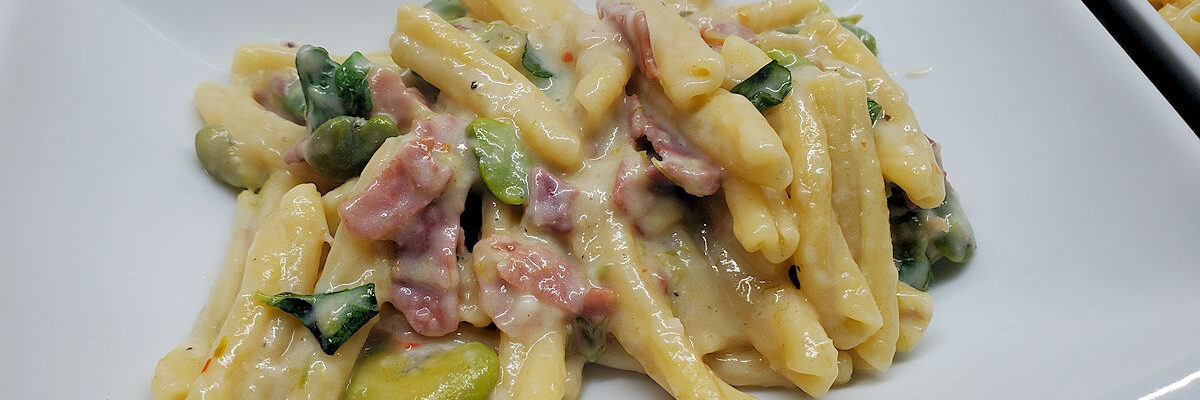
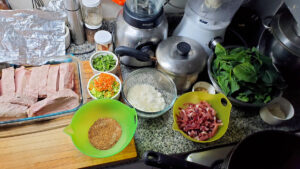
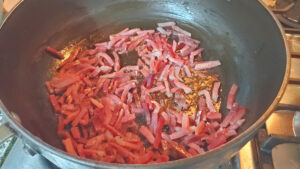
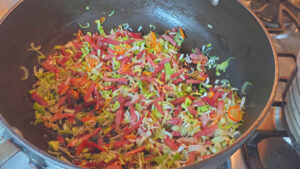
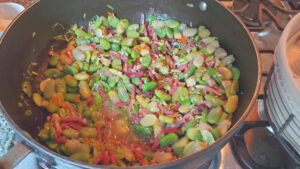
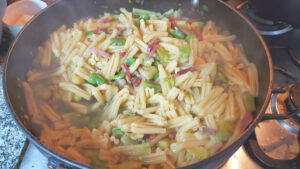
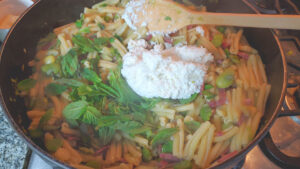
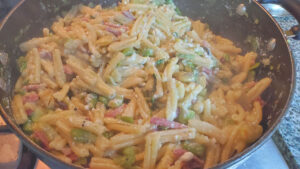
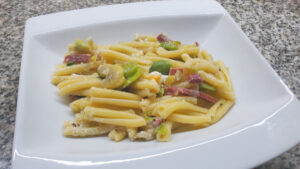
[…] le fave – Our version of this classic pasta dish from southern Italy and Sicily. I presented a step-by-step on how to make this a couple of months ago. Basically, casarecce pasta tossed with crispy prosciutto, broad beans, […]